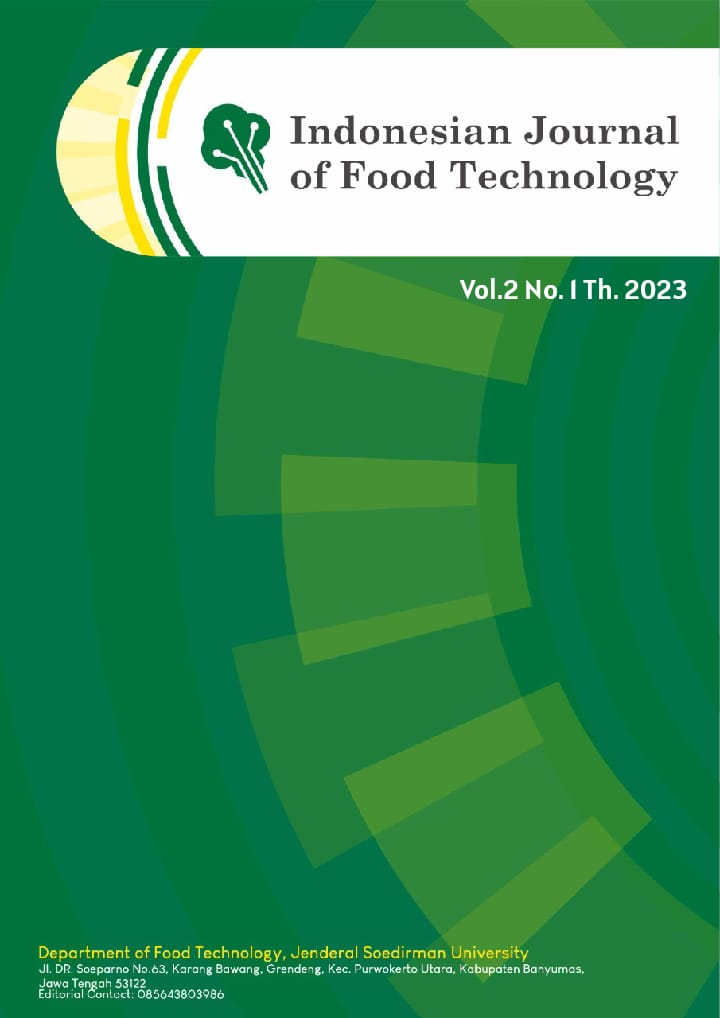Potential Analysis of Brown Sugar Industry Liquid Waste as Raw Material on Making Nata de Coco
Abstrak
Brown sugar industry liquid waste is a type of waste that has potential as a medium for making nata. This is because coconut sugar industry liquid waste still contains a lot of sugar as a source of nutrition for the growth of Acetobacter xylinum. In this study, a comparative analysis will be carried out to determine the feasibility of brown sugar industry liquid waste as a medium for making nata. The research was conducted for 2 months at UKM Ngudi Lestari Jaya, Kalisalak Village. Samples were taken randomly using sterile plastic bottles. Sample analysis includes viscosity, color, aroma, degree of brix and pH. Observations on viscosity, color and aroma were carried out before and after boiling. Variable measurements were carried out 3 times. The sensory properties of the samples were analyzed by descriptive qualitative. Brix degree and pH value were analyzed using SPSS version 2.1 with the independent t test method at an alpha value of 5%. The sensory and chemical properties of brown sugar industry liquid waste were compared with coconut water as a standard. The results showed that the liquid waste from the brown sugar industry had a dilute to slightly thick viscosity, light brown to brown color and normal aroma. The results of a comparative analysis showed that there was no difference in sensory properties between the liquid waste and coconut water before and after boiling. The brix degree and the pH value of brown sugar industry liquid waste were respectively 4.3% and 6.3. Meanwhile, the degree of brix and the pH value of coconut water were 5.1% and 5.6, respectively. Based on this, it can be concluded that the liquid waste of brown sugar industry has very good potential as a medium for making nata.
Referensi
Anam, M.Z. dan U. Khorunnisa. (2019). Mengungkap senyawa pada nata de coco sebagai pangan fungsional. Jurnal Ilmu Pangan dan Hasil Pertanian, 3(1):42-53.
Arfa, Y.A., S.W. Ahmad, D. Tryaswati, A. Nurhana. (2017). Pengaruh penambahan gula dan nitrogen pada produksi nata de coco. Biowallacea, 4(1):541-54
Basuki, M and R.U. Fahadha. (2020). Identification of the causes nata de coco production defects for quality control. Spektrum Industri,18(2): 1963-6590.
Fatimah, H. Nina dan R. Yulia. (2019). Pengaruh konsentrasi gula pasir dan gula aren pada pembuatan nata de Coco. Jurnal Teknologi Agro Industri 6(2):141-146.
Nugroho, D.A. and P. Aji. (2014). Characterization of nata de coco produced by fermentation of immobilized Acetobacter xylinum. The 2014 International Conference on Agro-industry (ICoA) : Competitive and sustainable Agro-industry for Human Welfare. Agriculture and Agricultural Science Procedia, 3(2015): 278 – 282.
Peni, N and M. Priska. (2021). Analisis kualitas nata de coco untuk pembuatan serbuk minuman instan kaya serat. CHEMICA : Jurnal Teknik Kimia, 8(1): 66-73.
Putri, S.N.Y., W.F. Syaharani, C.V.B. Utami, D.R. Safitri, Z.N. Arum, Z.S. Prihastari, A.R. Sari. (2021). The Effect of microorganism, raw materials, and incubation time on the characteristic of nata: A Review. Jurnal Teknologi Hasil Pertanian. 14(1): 62-74. URL:https://jurnal.uns.ac.id/ilmupangan/article/view/47654 DOi:https://doi.org/10.20961/jthp.v14i1.47654
Rahmayanti, H.D., N. Amalia, R.Munir, E. Yuliza, F.D. Utami, E. Sustini and Mikrajuddin Abdullah . (2019). A study of physical and mechanical properties of nata de coco in the market. IOP Conf. Series: Materials Science and Engineering, 599(2019): 012-031 doi:10.1088/1757-899X/599/1/012031
Rodiah, S.A., A.W. Putra, L. Advinda dan D.H. Putri. (2021). Pembuatan nata menggunakan air kelapa. Prosiding SEMNAS BIO 2021 Universitas Negeri DOI: https://doi.org/10.24036/prosemnasbio/vol1/98
Tining. (2023). Dorong Penguatan Industri Gula Kelapa Nasional, FTP UGM Tandatangani MoU dengan PT Integral Mulia Cipta. ttps://tpb.tp.ugm.ac.id/id/2023/04/13/dorong-penguatan-industri-gula-kelapa-nasional-ftp-ugm-tandatangani-mou-dengan-pt-integral-mulia-cipta.xhtml
Tutuarima, T., Y. Rosalina and A.A. Muthia. (2019). Utilization Of Coconut Water To Be Nata De Coco For Women In Pasar Panorama Bengkulu City. Dharma Raflesia Unib Tahun XVII, 1(2019): 57 – 63.
Widyaningrum, P., Dewi dan Bambang P. (2017). Evaluasi Sifat Fisik Nata De Coco Dengan Ekstrak Kecambah Sebagai Sumber Nitrogen. Seminar Nasional Pendidikan, Sains dan Teknologi Fakultas Matematika dan Ilmu Pengetahuan Alam, Universitas Muhammadiyah, Semarang.
Wijayanti, E. (2019). Peningkatan Ekonomi Masyarakat Melalui Home Industry Nata De Coco Berbasis Potensi Lokal. DIMAS, 19(1): 37 – 47.
Yanto, T, Karseno dan Maria M. D. Purnamasari. (2015). Pengaruh Jenis dan Konsentrasi Gula Terhadap Karakteristik Fisikokimia dan Sensori Jelly Drink. Jurnal Teknologi Hasil Pertanian, 8(2).




